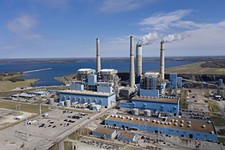Affordability Key to Climate Plan Goals
City task force makes its recommendations for 2024 climate change protection goals
By Nora Ankrum, Fri., July 18, 2014

It's been only three years since City Council approved – after much hand-wringing – Austin Energy's 2020 climate change protection goals, but already it's time for an update – and it's likely to be an ambitious one. Many of the current goals are within reach ahead of schedule, and Council has now mandated that new goals – set for 2024 – meet or exceed previous aspirations. As the Chronicle reported two weeks ago ("AE's Solar Deal: 'Game Changer,' " July 4), one reason for AE's rapid progress is a recent contract that secures a long-term supply of solar energy at a historically low price. On the heels of that achievement, the Austin Generation Resource Planning Task Force has now released draft recommendations for the 2024 plan – with solar taking a leading role.
Before the task force's report wends its way to Council, slight revisions are to come, followed by vetting from the public, including relevant boards and commissions. To kick-start that vetting process, the Chronicle spoke with task force Chair Michael Osborne, a former longtime AE executive, about the report, beginning with one of its seemingly most ambitious recommendations: accelerating City Council's recently declared goal of reaching net-zero carbon emissions by 2050. The task force recommends adjusting that timeline by 20 years, reaching net-zero by 2030.
That goal isn't as ambitious as it seems, says Osborne. Considering AE is on track to reach 35% renewables by 2016 and sources another 22% of its energy from nuclear, the utility is already poised to pass the halfway mark even without retiring the Decker Creek gas plant or the coal-fired Fayette Power Plant (both of which are on the task force's chopping block). The additional 1,200 megawatts of energy efficiency AE has built in over the last 12 years also makes a difference. "That's probably another 5 percent that would have been there that's not," Osborne adds.
The 2030 goal, says Osborne, is only advisable if current affordability metrics – passed by Council in 2011 – are maintained. In a nod to its importance, the report lists affordability as its very first recommendation and names it as an explicit caveat on the 2030 recommendation. Together, the affordability and 2030 goals are the "meta-resolutions" of a report that is not intended to be as "prescriptive" as its predecessor, says Osborne, referring to the 2010 task force report that formed the basis of the 2020 plan. This time around, he says, "We didn't tell 'em how to drive to Dallas – just get to Dallas however you can."
Nonetheless, the task force envisions the drive to Dallas to be a very sunny one. It recommends that solar be "the default new generation resource through 2024"; Osborne says that timing has much to do with this goal. Recently completed state-funded transmission lines offer a window of opportunity for early adopters, he says. Known as CREZ (Competitive Renewable Energy Zone), the project brings wind and solar from West Texas to highly populated load centers like Austin. "We [AE] pay for 4 percent of those, because we're 4 percent of the ERCOT [Electric Reliability Council of Texas] load," says Osborne, referring to the entity that oversees most of the state grid. "But why don't we use 15 percent of them now while they're underutilized?"
Federal solar incentives set to expire in 2016 provide additional reason for urgency. They're creating a buyer's market, says Osborne, and they allow AE to secure long-term low rates as a hedge against natural gas prices. Cost risk related to natural gas is a major theme of the task force's report, which recommends replacing AE's Decker gas plant entirely with West Texas solar by 2016. To bolster its case, the report points to reports that the gas market may be experiencing a bubble.
Osborne cautions that the task force isn't recommending AE wean off natural gas altogether. The goal, he says, is to start a "robust conversation on the fact that when you make a commitment to a billion-dollar gas plant, or whatever [price] it is, at the same time you make an even huger commitment to buy gas for that plant for the 30 or 40 years that you're going to run it."
The report also addresses coal. Council has long sought a way out of the coal-fired Fayette plant, but given co-ownership with the Lower Colorado River Authority, the city has yet to figure out a way to retire, sell, or even ramp down its share. To this end, the task force recommends that AE seek 100% ownership of one unit (it currently co-owns two units – half of each). To nudge the process along, the report suggests that AE's contract with the LCRA – which does not allow sale or division of the property – may be "unlawful."
"We threw that in there as a possible way to break the logjam," says Osborne. "People say we can't do this, we can't do that. ... We're just trying to get things moving forward there." Speaking of moving forward, the report is now undergoing minor revision before appearing at the Electric Utility Commission on July 21. For the full report and list of recommendations, which address water use, energy storage, zero-energy building, and more, see www.austinenergy.com.
Got something to say on the subject? Send a letter to the editor.










